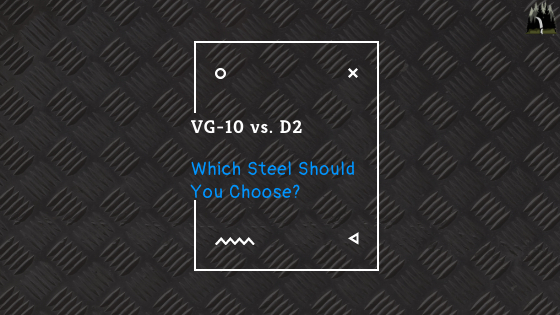When it comes to choosing the right steel for your knife, there are many factors to consider, such as edge retention, corrosion resistance, toughness, and ease of sharpening. Two popular steels in the knife-making community are VG-10 and D2. In this article, we will take an in-depth look at each of these steels and compare their respective characteristics to help you make an informed decision.
Here is the short answer:
VG-10 is a high-quality stainless steel that is easy to sharpen and offers excellent corrosion resistance. D2, on the other hand, is a high-carbon tool steel that is known for its exceptional edge retention and toughness. If you need a good edge, go for D2. Otherwise, go for VG-10.
With the short answer out of the way, we can look in-depth at each steel, what they are made of, how they compare to each other, and the best knives in each steel.
In-depth look at VG-10
VG-10 is a Japanese-made stainless steel that was developed by Takefu Special Steel Company. It is a high-quality steel that is often used in high-end knives and cutting tools. VG-10 contains a high amount of chromium (15%), which gives it excellent corrosion resistance, as well as a small amount of vanadium (0.2%), which helps to improve its edge retention.
One of the standout characteristics of VG-10 is its ease of sharpening. It is a relatively soft steel compared to other high-performance steels, which means that it can be sharpened easily with a sharpening stone or other sharpening tool. However, its relatively soft nature also means that it may not hold an edge as long as some other high-performance steels.
In terms of toughness, VG-10 is a fairly durable steel that can withstand moderate use without chipping or breaking. However, it may not be as tough as some other steels, such as D2 or CPM S30V.
Here is what VG-10 is made of:
- 1% carbon
- 15.5% chromium
- 1.2% molybdenum
- 0.3% vanadium
- 0.5% manganese
- 1.5% cobalt
Each component of the steel does different things: Carbon increases strength and edge retention, chromium will increase corrosion resistance and edge retention, vanadium will increase wear resistance, and manganese will increase strength.
In-depth look at D2
D2 is a high-carbon tool steel that is often used in industrial applications such as forging dies and cutting tools. It contains a high amount of carbon (1.5%), which gives it exceptional edge retention, as well as chromium (12%), which provides it with good corrosion resistance.
D2 is known for its toughness and durability, making it a popular choice for high-end knives and other cutting tools. It can withstand heavy use without chipping or breaking, and its high carbon content allows it to hold a sharp edge for a long time. However, its hardness can also make it more difficult to sharpen than other steels.
Here is what D2 is made of:
- carbon: 1.5%
- Chromium: 12%
- Vanadium: 0.9%
- Molybdenum: 0.8%
- Magnesium: 0.45%
- Silicon: 0.4%
- Sulfur: 0.02%
Sulfur and silicon–much like carbon–will increase strength but to a lesser extent.
In-depth comparison
When comparing VG-10 and D2, one of the most notable differences is their carbon content. D2 contains a much higher amount of carbon than VG-10, which gives it superior edge retention but also makes it more brittle and more difficult to sharpen.
Another key difference between the two steels is their corrosion resistance. VG-10 contains a higher amount of chromium than D2, which gives it better corrosion resistance. This makes VG-10 a better choice for knives that will be used in wet or humid environments.
When it comes to toughness, D2 is generally considered to be tougher and more durable than VG-10. This is due in part to its high carbon content, which gives it greater strength and hardness.
In terms of sharpening, VG-10 is generally easier to sharpen than D2 due to its softer nature. However, this also means that VG-10 may not hold an edge as long as D2.
Best knives in each steel
Now that we have looked in depth at each steel and compared both steels in depth, we can look at the best knives in each steel.
SOG Aegis (D2)
The SOG Aegis is a knife that is very high quality and will work for any task you want it to. My favorite part of the Aegis is its stout assisted opening that ensures your knife will open every time. If you are looking for a new EDC knife that is very reliable, this is the knife for you.
Check out this knife here (link to Amazon)
Spyderco DragonFly 2 (VG-10)
The Spyderco DragonFly is a high-quality, lightweight, smooth-opening EDC knife. It has a 2.3-inch VG-10 blade, an FRN handle, a thumbhole for opening, and weight only 1.2 ounces. If you want a compact lightweight EDC knife you should check this one out.
Here is a link to this knife (link to Amazon)
Conclusion
VG-10 and D2 are both high-quality steels that offer excellent performance in different areas. VG-10 is known for its ease of sharpening and corrosion resistance, while D2 is prized for its exceptional edge retention and toughness. When choosing between these two steels, it’s important to consider your specific needs and preferences.
If you need a knife that will hold an edge for a long time and can withstand heavy use, D2 may be the better choice. However, if you prioritize ease of sharpening and corrosion resistance, then VG-10 may be the better choice. It’s also worth noting that there are many other factors that can influence a steel’s performance, such as heat treatment, blade geometry, and use case. Ultimately, the choice between VG-10 and D2 will depend on your personal preferences and the intended use of the knife.
Both VG-10 and D2 are popular choices among knife enthusiasts and professionals alike, and for good reason. They are both high-performance steels that offer excellent characteristics for a variety of cutting tasks. By understanding the strengths and weaknesses of each steel, you can make an informed decision and choose the right steel for your needs.

